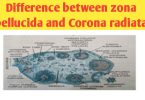What is difference between purines and pyrimidines l definition and examples of purines l definition and examples of pyrimidines.
As you know that a nucleic acid is a macromolecule. it is chains of monomeric nucleotides, nucleotides are the information molecules of the cell, it is consists of three phosphoric acid, a sugar molecules, a molecules of nitrogenous organic base, all linked together by covalent bond.

What is difference between purines and pyrimidines
The organic base of a nucleotides is either a pyramidine or a purienes. It takes part in synthesise of DNA and RNA, therefore they are building blocks of genetic material.
How does a purine differ from pyrimidine?, when you compare between purines and pyramidines, purines is double ring structure of a 9-membered molecules, adenine(A) and guanine(G) are two important purines while pyramidines is single ring of hexagon structure of a 6 -membered molecules, thymine(T), cytosine (C) and uracil (U) are three important pyramidines.
Hi guys in this article we know about definition of purines and pyramidines with examples and compare / differences /contrast and distinguish between purines and pyramidines.
Definition and examples of purines
Definition of purines:- It is a heterocyclic aromatic organic compounds with a chemical formula of C5H4N4, it is consists of two rings pyrimidine and imidazole, it includes two of the bases in DNA and RNA, it is water soluble, purines are found in high concentration in meat and meat products, plant based diets are low in purines, the purines nucleotides bases are guanine (G) and adenine(A). Examples of high purines sources are liver, sardines, beer, spirulina etc.
Definition and examples of pyramidines
Definition of pyramidines:- It is an aromatic heterocyclic organic compounds, its chemical formula is C4H4N2, it is consists of three types of nitrogenous bases cytosine(C), thymine(T) and uracil (U). It includes three of the bases in DNA and RNA. It is found in many synthetic compounds such as barbiturates and the HIV drug, zidovudine. Examples of pyrimidines sources are uric acid.
YOU CAN ALSO SEE THIS VIDEO
You can also click on the given link to see others topic in our website and YouTube channels
◆ ALSO READ: HEART ANATOMY, PHYSIOLOGY, LOCATION, DISEASE & TREATMENT
What is difference between purines and pyrimidines
This question is very important for class 8th, 9th, 10th and 12th students those preparing for competitive and annual board examination.
Regarding this, “what is difference between purines and pyramidines”, purines molecules is larger and has two rings, at 6- member ring joined to a 5- member ring at 4′ and 5′ positions and carries nitrogen at 7′ and 9′ positions also besides at 1′ and 3′ positions, adenine(A) and guanine (G) are two important purines and it is a 9 membered molecule whereas pyramidine molecules is smaller and has one 6 member ring, with nitrogen at 1′ and 3′ positions, thymine(T), cytosine (C) and uracil(U) are three important nitrogenous bases of pyrimidines.
Compare / difference/ between purines and pyramidines are as follows:-
Purines :-
1. Purines are heterocyclic aromatic organic compounds, consisting of a pyrimidines ring fused to a imidazole ring.
2. It contains two carbons nitrogen rings and for nitrogen atoms.
3. It contains comparatively high melting point and boiling point.
4. Purines are synthesized by Traube purine synthesis method.
5. Purines help in the production of RNA and DNA protein and starch the regulation of enzymes and cell signalling.
6. There are two important nitrogenous bases in purines :- Adenine(A) and guanine (G).
7. It has nitrogen atom at 1′ , 3′ ,7′ and 9′ positions.
8. Purine molecules is larger than pyrimidine molecules.
9. Its molecules consists of 2 rings joined at 4′ and 5′ positions.
10. Purine is a 9- membered molecule.
11.Catabolism of purines produces uric acid
12. Purines form important biomolecules in the cell like ATP, GTP, NAD, cyclic AMP and coenzymes.
13. Purines are synthesized as nucleosides, which are attached to ribose sugars,both de novo and salvage pathways are involved in the biosynthesis of purines.
Pyrimidines:-
1. pyrimidine are heterocyclic aromatic organic compounds, similar to benzene,it is isomeric with two others forms of diazine.
2. its contain a single carbon – nitrogen ring and 2 nitrogen atoms at 1, 3 position
3. Its contain comparatively low melting and boiling points.
4. Pyrimidines are synthesized by Biginelli reaction.
5. its function in formation of nucleic acid and in cell metabolism, activation of sugar for polysaccharide and phospholipid synthesis.
6. There are there important nitrogenous bases in pyrimidines :- thymine(T), cytosine (C) , and uracil (U).
7. it has nitrogen atom at 1′ and 3 ‘ positions.
8. pyramidines molecule is smaller than purine molecule.
9. its molecules is a single ring.
10. pyramidines is a 6- membered molecule.
11. Catabolism of pyramidines produces beta amino acids, carbon dioxide, and ammonia.
12. Pyrimidines molecule form important biomolecules found in DNA,RNA.
13. pyrimidines are synthesized as nucleosides ,using both de novo and salvage pathways inside the cell, UMP uridine monophosphate is the precursor producing in the de novo pathways, which is involved in the synthesis of uracil, cytosine and thymine.
Conclusions:-
Purines and pyramidines are the two repeating building blocks in nucleic acids involves in the storage of genetic information in the cell required for the development, functioning and reproduction of organisms takes place.







Leave a Comment